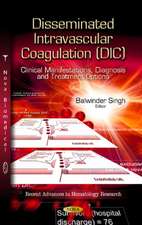Treating Life-Threatening Bleedings: Development of Recombinant Coagulation Factor VIIa
Autor Ulla Hedneren Limba Engleză Paperback – 5 iul 2017
The book stresses the importance of patient care in the learning process and provides new ideas on how to approach diseases and their treatment. Users will find a real world example that will act as a timely resource for those learning about, or engaged in, performing and supervising research across the biomedical sciences.
- Documents the successful roadmap of the development of a new concept of treating major bleedings in the most life-threatening situations
- Stresses the importance of the close connection between the clinic and research, describing how a new concept of hemostasis was revealed by careful clinical observation
- Offers real-world research and development context for drug discovery, and for the treatment of hemophilia and other bleeding disorders
Preț: 363.32 lei
Preț vechi: 453.94 lei
-20% Nou
Puncte Express: 545
Preț estimativ în valută:
69.53€ • 71.83$ • 57.83£
69.53€ • 71.83$ • 57.83£
Carte tipărită la comandă
Livrare economică 12-26 martie
Preluare comenzi: 021 569.72.76
Specificații
ISBN-13: 9780128124390
ISBN-10: 0128124393
Pagini: 214
Dimensiuni: 152 x 229 x 14 mm
Greutate: 0.34 kg
Editura: ELSEVIER SCIENCE
ISBN-10: 0128124393
Pagini: 214
Dimensiuni: 152 x 229 x 14 mm
Greutate: 0.34 kg
Editura: ELSEVIER SCIENCE
Public țintă
Residents, fellows and professionals in hematology, pathology, surgery, internal/hospital medicine, public healthCuprins
1. Classical Bleeding Disease (Hemophilia)2. My Encounter With Hemophilia (1959-82)3. The First Years at Novo Nordisk4. The Development of Recombinant FVIIa (rFVIIa) (1985-88)5. The Further Use and Development of rFVIIa (1989-96)6. Legal Issues Regarding the Use of rFVIIa in Hemophilia Patients With Inhibitors7. Treatment With rFVIIa in Malmö (1996-99)8. The Launching and Uses of rFVIIa9. Mechanism of Action and Dosage10. The Continued Development of rFVIIa During the 2000s11. Safety and Health Economy of rFVIIa12. Three Different Descriptions of How rFVIIa Was Developed13. Some Final Remarks



